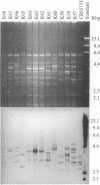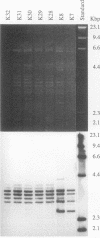Abstract
The use of restriction endonuclease analysis and Southern hybridization with our new CkF1,2 DNA probe, cold labeled with peroxidase, for the typing of Candida krusei isolates has been investigated. Fifty-five clinical samples isolated from forty-five patients hospitalized in eight centers, one environmental strain, and two reference strains were evaluated. Patterns were analyzed by a computer-assisted method and compared by numerical analysis. Clearer and less ambiguous patterns were obtained by restriction with endonuclease HinfI. It generated 9 to 14 (average, 11) well-separated fragments in the range of 6.5 to 2.0 kb. Both their numbers and sizes varied greatly among the strains studied. The CkF1,2 probe hybridized with one to seven fragments of HinfI patterns. A total of 48 distinct types were distinguished among the 58 strains studied. HinfI and CkF1,2 patterns showed similarities of less than 83 and 75% for unrelated strains and more than 91 and 100% for related strains, respectively. The methods showed 100% typeability, 98% reproducibility, and a discriminatory power of 1. C. krusei isolates from each patient were distinct, whether from one hospital or from different hospitals. Multiple isolates from the same patient were identical, both over time and at different anatomic sites. An endogenous origin is suggested for the colonizing and infecting isolates among the 45 patients. The CkF1,2 probe enhanced discrimination of the strains and provided a definitive comparison for strain identity. Genetic linkages between isolates were assessed at the subspecies level, and 12 clusters were delineated. A typing scheme is proposed for epidemiological studies of C. krusei.
Full text
PDF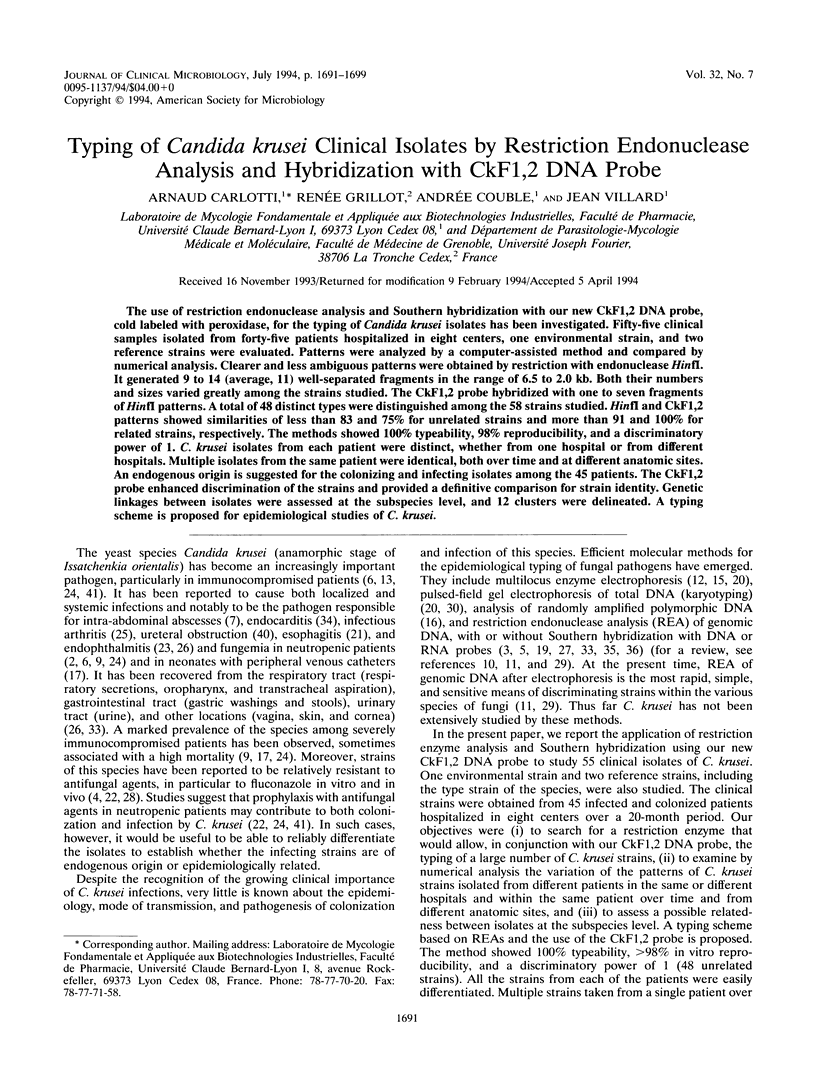

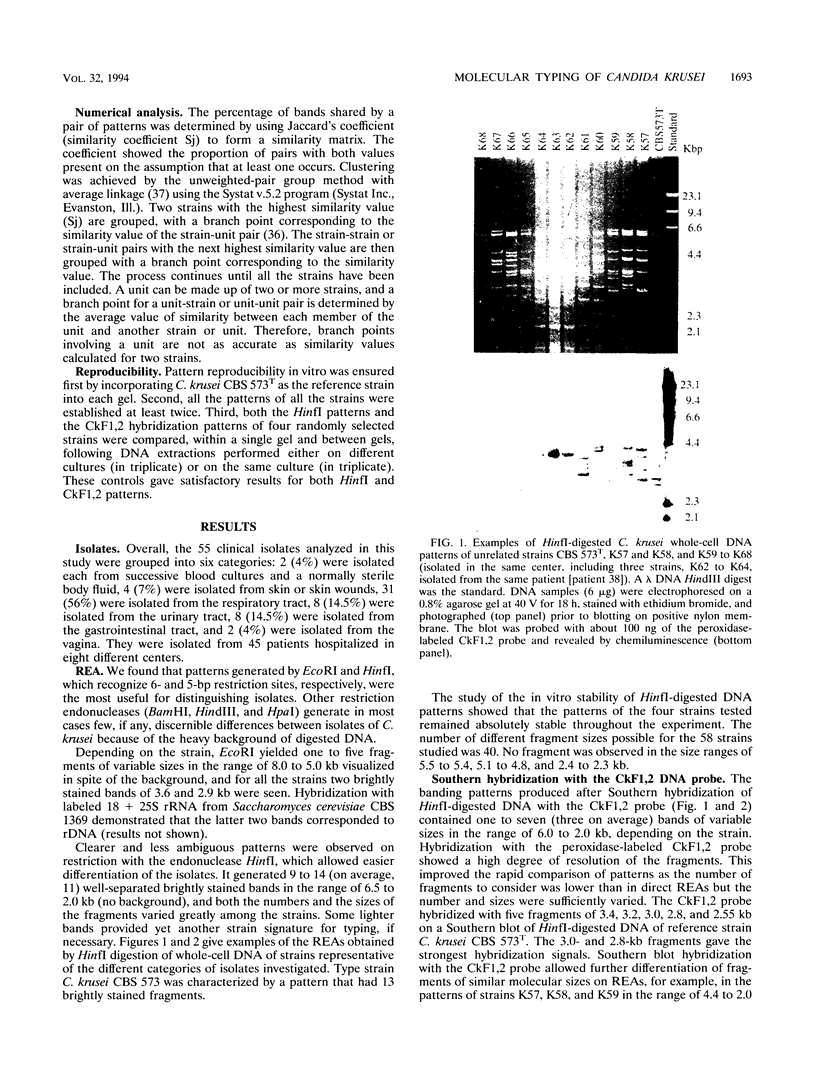
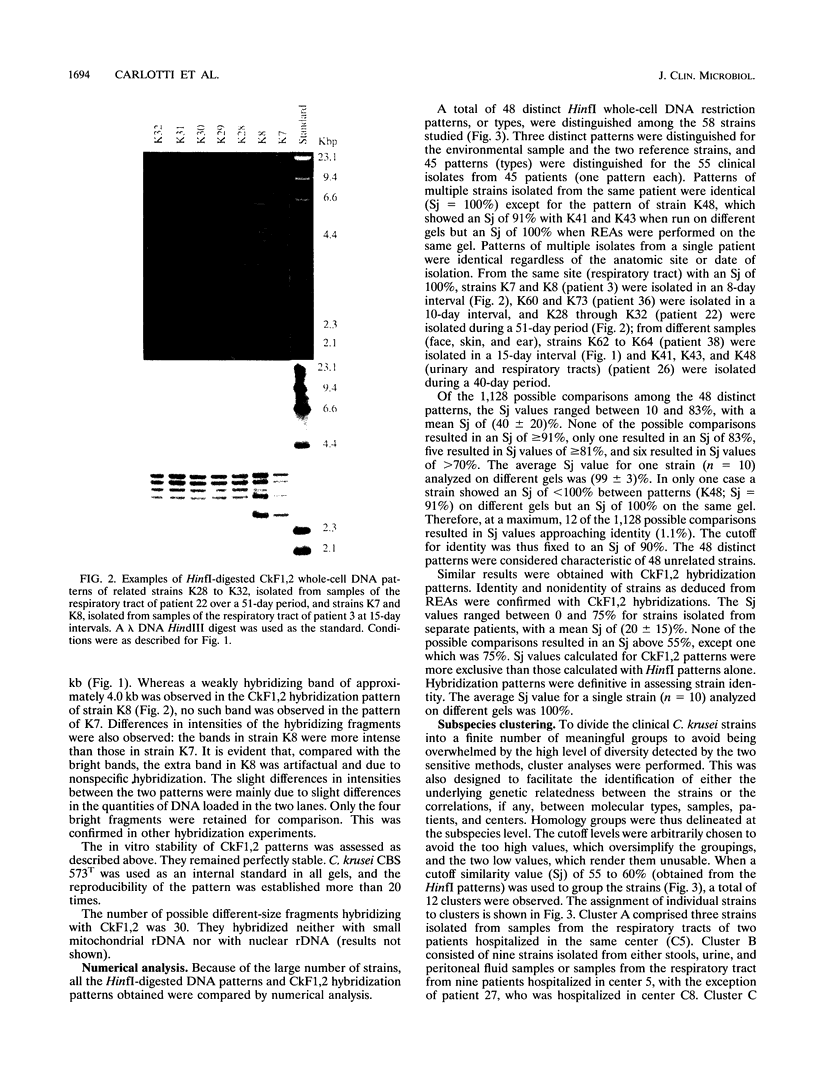
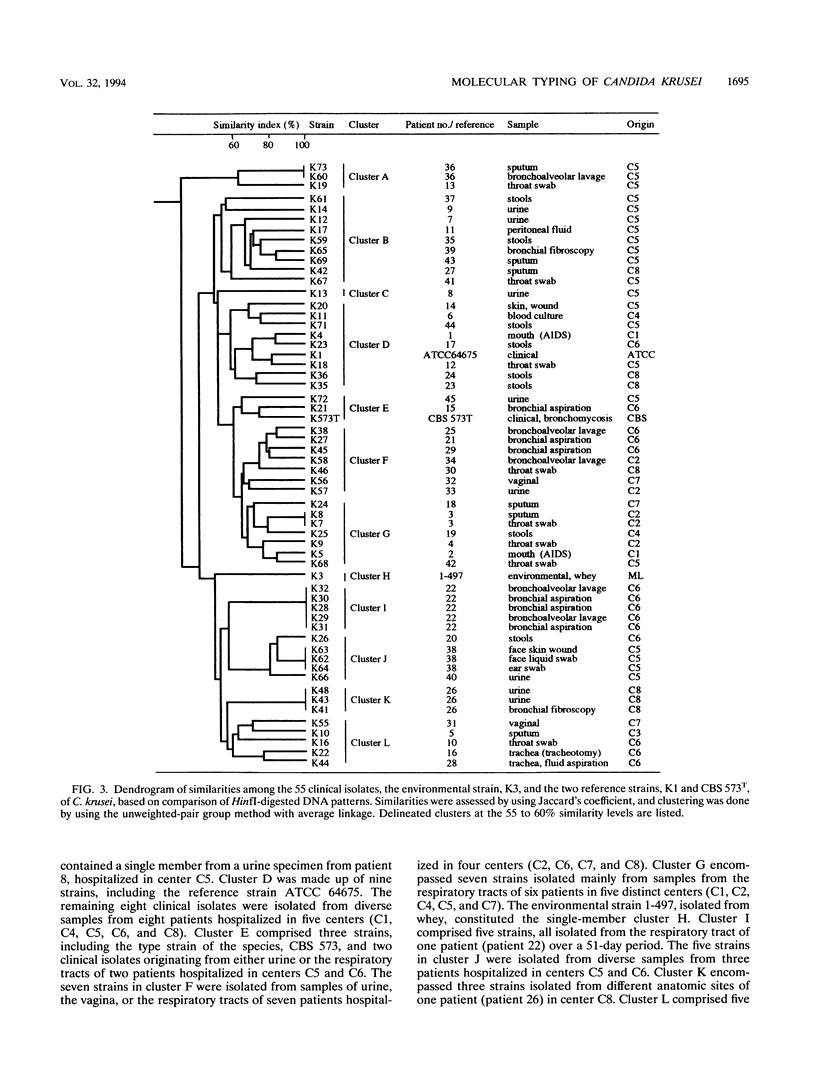
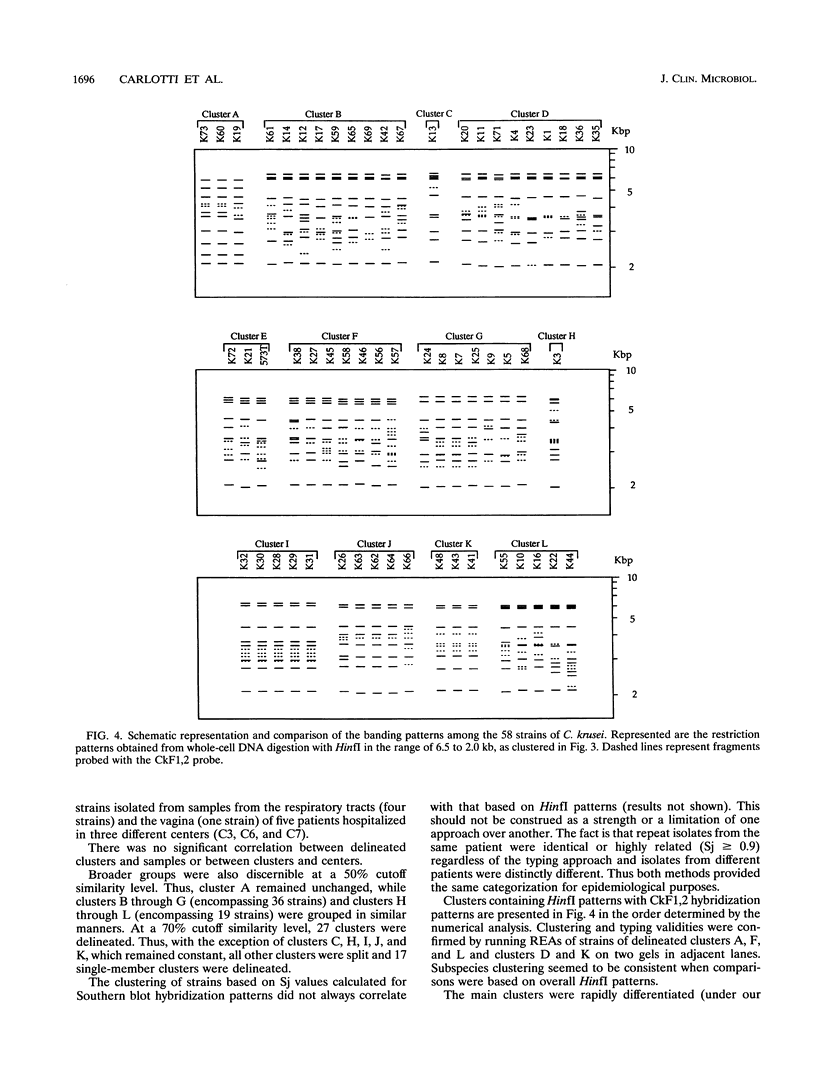
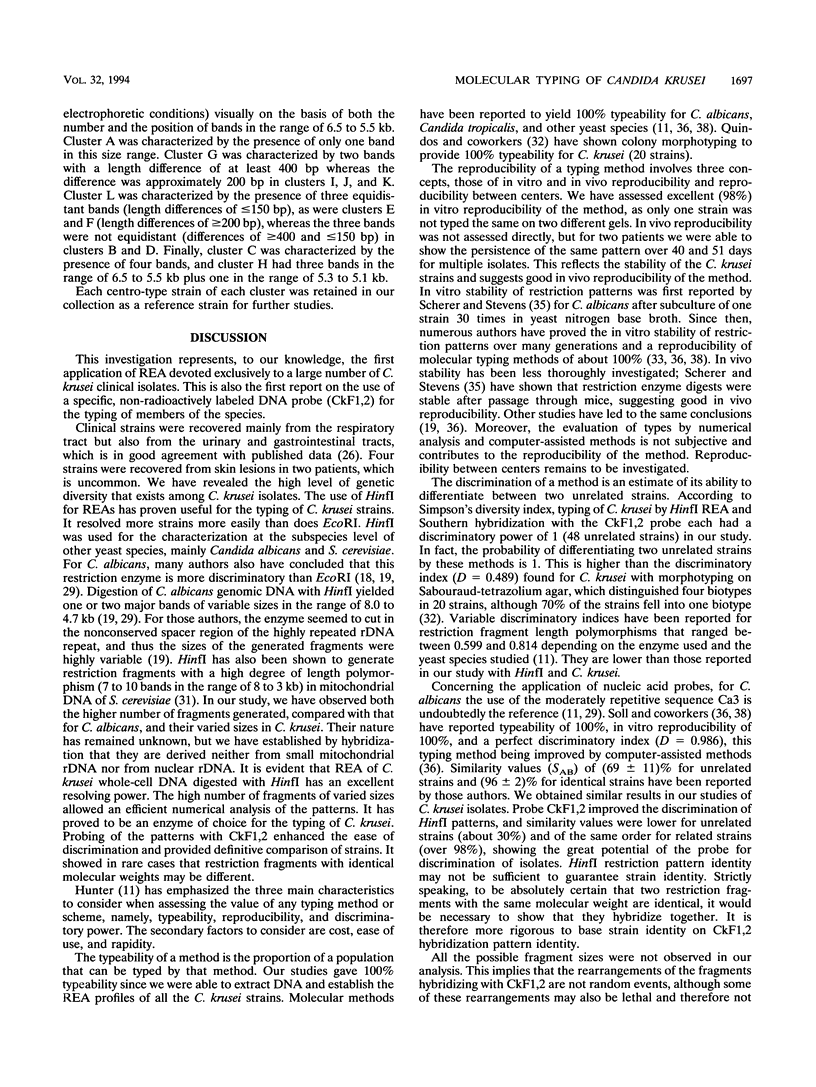
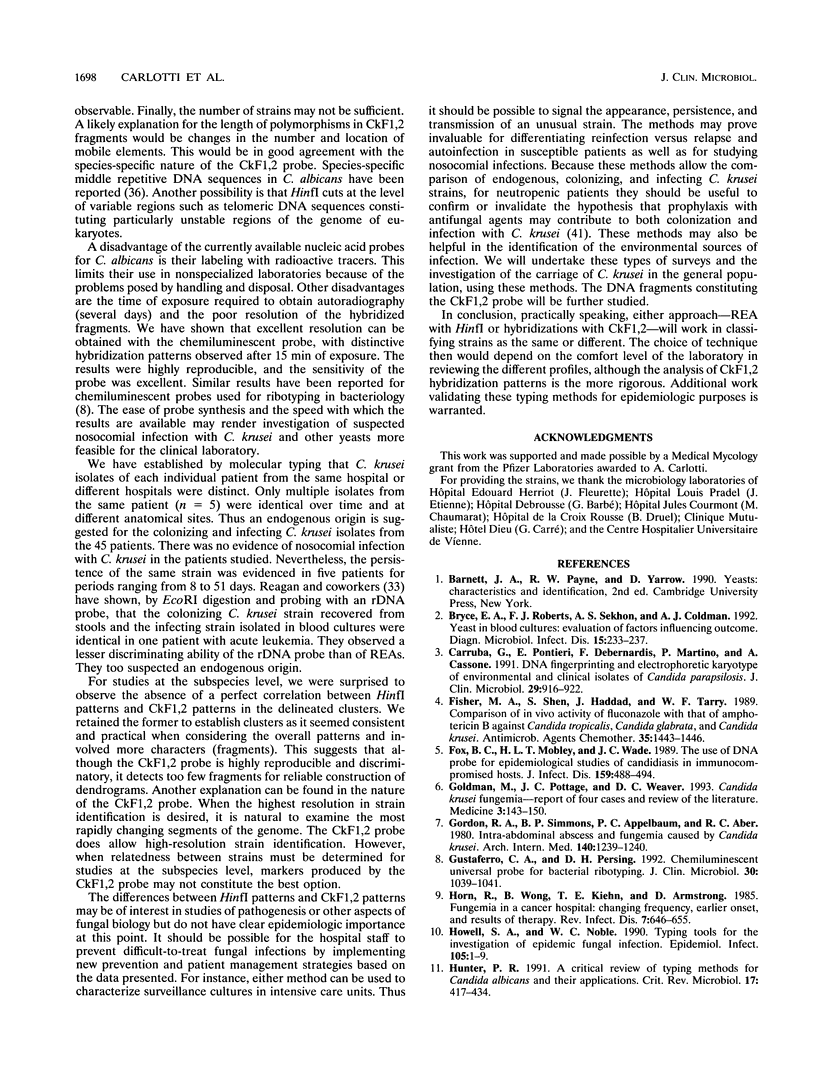
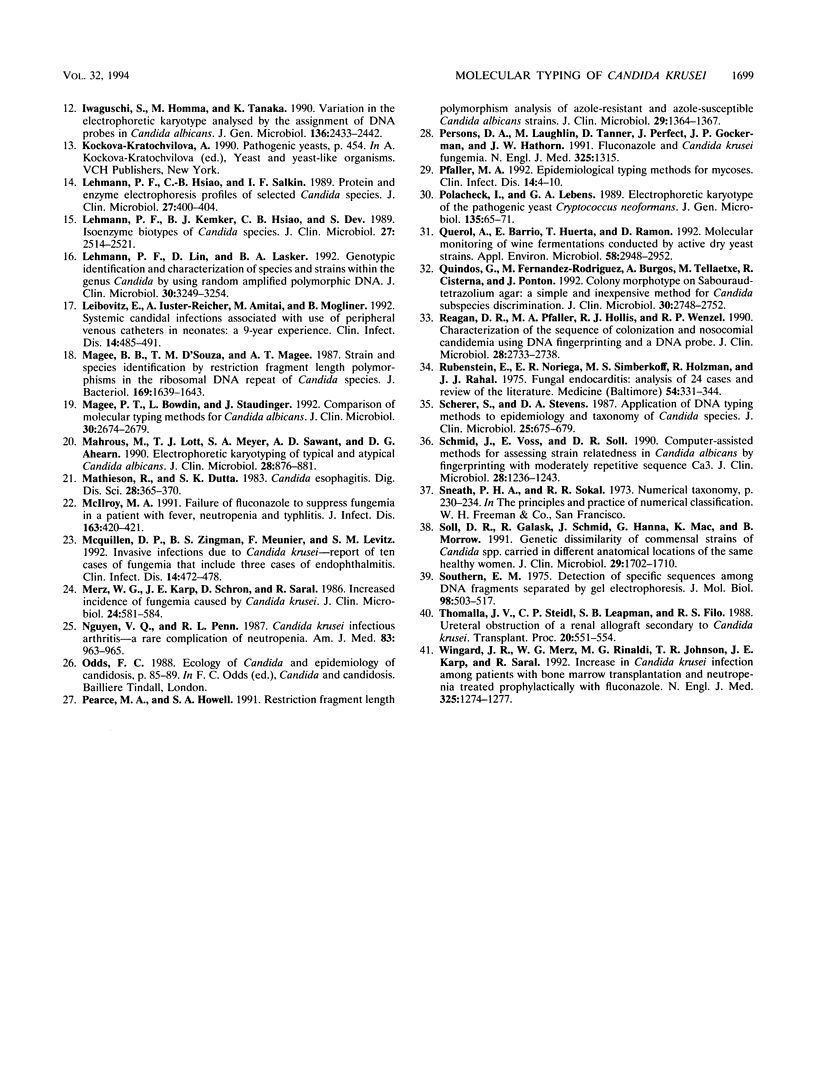
Images in this article
Selected References
These references are in PubMed. This may not be the complete list of references from this article.
- Bryce E. A., Roberts F. J., Sekhon A. S., Coldman A. J. Yeast in blood cultures. Evaluation of factors influencing outcome. Diagn Microbiol Infect Dis. 1992 Mar-Apr;15(3):233–237. doi: 10.1016/0732-8893(92)90118-d. [DOI] [PubMed] [Google Scholar]
- Carruba G., Pontieri E., De Bernardis F., Martino P., Cassone A. DNA fingerprinting and electrophoretic karyotype of environmental and clinical isolates of Candida parapsilosis. J Clin Microbiol. 1991 May;29(5):916–922. doi: 10.1128/jcm.29.5.916-922.1991. [DOI] [PMC free article] [PubMed] [Google Scholar]
- Fisher M. A., Shen S. H., Haddad J., Tarry W. F. Comparison of in vivo activity of fluconazole with that of amphotericin B against Candida tropicalis, Candida glabrata, and Candida krusei. Antimicrob Agents Chemother. 1989 Sep;33(9):1443–1446. doi: 10.1128/aac.33.9.1443. [DOI] [PMC free article] [PubMed] [Google Scholar]
- Fox B. C., Mobley H. L., Wade J. C. The use of a DNA probe for epidemiological studies of candidiasis in immunocompromised hosts. J Infect Dis. 1989 Mar;159(3):488–494. doi: 10.1093/infdis/159.3.488. [DOI] [PubMed] [Google Scholar]
- Goldman M., Pottage J. C., Jr, Weaver D. C. Candida krusei fungemia. Report of 4 cases and review of the literature. Medicine (Baltimore) 1993 May;72(3):143–150. [PubMed] [Google Scholar]
- Gordon R. A., Simmons B. P., Appelbaum P. C., Aber R. C. Intra-abdominal abscess and fungemia caused by candida krusei. Arch Intern Med. 1980 Sep;140(9):1239–1240. [PubMed] [Google Scholar]
- Gustaferro C. A., Persing D. H. Chemiluminescent universal probe for bacterial ribotyping. J Clin Microbiol. 1992 Apr;30(4):1039–1041. doi: 10.1128/jcm.30.4.1039-1041.1992. [DOI] [PMC free article] [PubMed] [Google Scholar]
- Horn R., Wong B., Kiehn T. E., Armstrong D. Fungemia in a cancer hospital: changing frequency, earlier onset, and results of therapy. Rev Infect Dis. 1985 Sep-Oct;7(5):646–655. doi: 10.1093/clinids/7.5.646. [DOI] [PubMed] [Google Scholar]
- Howell S. A., Noble W. C. Typing tools for the investigation of epidemic fungal infection. Epidemiol Infect. 1990 Aug;105(1):1–9. doi: 10.1017/s0950268800047580. [DOI] [PMC free article] [PubMed] [Google Scholar]
- Hunter P. R. A critical review of typing methods for Candida albicans and their applications. Crit Rev Microbiol. 1991;17(6):417–434. doi: 10.3109/10408419109115206. [DOI] [PubMed] [Google Scholar]
- Iwaguchi S., Homma M., Tanaka K. Variation in the electrophoretic karyotype analysed by the assignment of DNA probes in Candida albicans. J Gen Microbiol. 1990 Dec;136(12):2433–2442. doi: 10.1099/00221287-136-12-2433. [DOI] [PubMed] [Google Scholar]
- Lehmann P. F., Hsiao C. B., Salkin I. F. Protein and enzyme electrophoresis profiles of selected Candida species. J Clin Microbiol. 1989 Mar;27(3):400–404. doi: 10.1128/jcm.27.3.400-404.1989. [DOI] [PMC free article] [PubMed] [Google Scholar]
- Lehmann P. F., Kemker B. J., Hsiao C. B., Dev S. Isoenzyme biotypes of Candida species. J Clin Microbiol. 1989 Nov;27(11):2514–2521. doi: 10.1128/jcm.27.11.2514-2521.1989. [DOI] [PMC free article] [PubMed] [Google Scholar]
- Lehmann P. F., Lin D., Lasker B. A. Genotypic identification and characterization of species and strains within the genus Candida by using random amplified polymorphic DNA. J Clin Microbiol. 1992 Dec;30(12):3249–3254. doi: 10.1128/jcm.30.12.3249-3254.1992. [DOI] [PMC free article] [PubMed] [Google Scholar]
- Leibovitz E., Iuster-Reicher A., Amitai M., Mogilner B. Systemic candidal infections associated with use of peripheral venous catheters in neonates: a 9-year experience. Clin Infect Dis. 1992 Feb;14(2):485–491. doi: 10.1093/clinids/14.2.485. [DOI] [PubMed] [Google Scholar]
- Magee B. B., D'Souza T. M., Magee P. T. Strain and species identification by restriction fragment length polymorphisms in the ribosomal DNA repeat of Candida species. J Bacteriol. 1987 Apr;169(4):1639–1643. doi: 10.1128/jb.169.4.1639-1643.1987. [DOI] [PMC free article] [PubMed] [Google Scholar]
- Magee P. T., Bowdin L., Staudinger J. Comparison of molecular typing methods for Candida albicans. J Clin Microbiol. 1992 Oct;30(10):2674–2679. doi: 10.1128/jcm.30.10.2674-2679.1992. [DOI] [PMC free article] [PubMed] [Google Scholar]
- Mahrous M., Lott T. J., Meyer S. A., Sawant A. D., Ahearn D. G. Electrophoretic karyotyping of typical and atypical Candida albicans. J Clin Microbiol. 1990 May;28(5):876–881. doi: 10.1128/jcm.28.5.876-881.1990. [DOI] [PMC free article] [PubMed] [Google Scholar]
- Mathieson R., Dutta S. K. Candida esophagitis. Dig Dis Sci. 1983 Apr;28(4):365–370. doi: 10.1007/BF01324956. [DOI] [PubMed] [Google Scholar]
- McIlroy M. A. Failure of fluconazole to suppress fungemia in a patient with fever, neutropenia, and typhlitis. J Infect Dis. 1991 Feb;163(2):420–421. doi: 10.1093/infdis/163.2.420. [DOI] [PubMed] [Google Scholar]
- McQuillen D. P., Zingman B. S., Meunier F., Levitz S. M. Invasive infections due to Candida krusei: report of ten cases of fungemia that include three cases of endophthalmitis. Clin Infect Dis. 1992 Feb;14(2):472–478. doi: 10.1093/clinids/14.2.472. [DOI] [PubMed] [Google Scholar]
- Merz W. G., Karp J. E., Schron D., Saral R. Increased incidence of fungemia caused by Candida krusei. J Clin Microbiol. 1986 Oct;24(4):581–584. doi: 10.1128/jcm.24.4.581-584.1986. [DOI] [PMC free article] [PubMed] [Google Scholar]
- Nguyen V. Q., Penn R. L. Candida krusei infectious arthritis. A rare complication of neutropenia. Am J Med. 1987 Nov;83(5):963–965. doi: 10.1016/0002-9343(87)90660-7. [DOI] [PubMed] [Google Scholar]
- Pearce M. A., Howell S. A. Restriction fragment length polymorphism analysis of azole-resistant and azole-susceptible Candida albicans strains. J Clin Microbiol. 1991 Jul;29(7):1364–1367. doi: 10.1128/jcm.29.7.1364-1367.1991. [DOI] [PMC free article] [PubMed] [Google Scholar]
- Persons D. A., Laughlin M., Tanner D., Perfect J., Gockerman J. P., Hathorn J. W. Fluconazole and Candida krusei fungemia. N Engl J Med. 1991 Oct 31;325(18):1315–1315. [PubMed] [Google Scholar]
- Pfaller M. A. Epidemiological typing methods for mycoses. Clin Infect Dis. 1992 Mar;14 (Suppl 1):S4–10. doi: 10.1093/clinids/14.supplement_1.s4. [DOI] [PubMed] [Google Scholar]
- Polacheck I., Lebens G. A. Electrophoretic karyotype of the pathogenic yeast Cryptococcus neoformans. J Gen Microbiol. 1989 Jan;135(1):65–71. doi: 10.1099/00221287-135-1-65. [DOI] [PubMed] [Google Scholar]
- Querol A., Barrio E., Huerta T., Ramón D. Molecular monitoring of wine fermentations conducted by active dry yeast strains. Appl Environ Microbiol. 1992 Sep;58(9):2948–2953. doi: 10.1128/aem.58.9.2948-2953.1992. [DOI] [PMC free article] [PubMed] [Google Scholar]
- Quindós G., Fernández-Rodríguez M., Burgos A., Tellaetxe M., Cisterna R., Pontón J. Colony morphotype on Sabouraud-triphenyltetrazolium agar: a simple and inexpensive method for Candida subspecies discrimination. J Clin Microbiol. 1992 Oct;30(10):2748–2752. doi: 10.1128/jcm.30.10.2748-2752.1992. [DOI] [PMC free article] [PubMed] [Google Scholar]
- Reagan D. R., Pfaller M. A., Hollis R. J., Wenzel R. P. Characterization of the sequence of colonization and nosocomial candidemia using DNA fingerprinting and a DNA probe. J Clin Microbiol. 1990 Dec;28(12):2733–2738. doi: 10.1128/jcm.28.12.2733-2738.1990. [DOI] [PMC free article] [PubMed] [Google Scholar]
- Rubinstein E., Noriega E. R., Simberkoff M. S., Holzman R., Rahal J. J., Jr Fungal endocarditis: analysis of 24 cases and review of the literature. Medicine (Baltimore) 1975 Jul;54(4):331–334. [PubMed] [Google Scholar]
- Scherer S., Stevens D. A. Application of DNA typing methods to epidemiology and taxonomy of Candida species. J Clin Microbiol. 1987 Apr;25(4):675–679. doi: 10.1128/jcm.25.4.675-679.1987. [DOI] [PMC free article] [PubMed] [Google Scholar]
- Schmid J., Voss E., Soll D. R. Computer-assisted methods for assessing strain relatedness in Candida albicans by fingerprinting with the moderately repetitive sequence Ca3. J Clin Microbiol. 1990 Jun;28(6):1236–1243. doi: 10.1128/jcm.28.6.1236-1243.1990. [DOI] [PMC free article] [PubMed] [Google Scholar]
- Soll D. R., Galask R., Schmid J., Hanna C., Mac K., Morrow B. Genetic dissimilarity of commensal strains of Candida spp. carried in different anatomical locations of the same healthy women. J Clin Microbiol. 1991 Aug;29(8):1702–1710. doi: 10.1128/jcm.29.8.1702-1710.1991. [DOI] [PMC free article] [PubMed] [Google Scholar]
- Southern E. M. Detection of specific sequences among DNA fragments separated by gel electrophoresis. J Mol Biol. 1975 Nov 5;98(3):503–517. doi: 10.1016/s0022-2836(75)80083-0. [DOI] [PubMed] [Google Scholar]
- Thomalla J. V., Steidle C. P., Leapman S. B., Filo R. S. Ureteral obstruction of a renal allograft secondary to Candida krusei. Transplant Proc. 1988 Jun;20(3):551–554. [PubMed] [Google Scholar]
- Wingard J. R., Merz W. G., Rinaldi M. G., Johnson T. R., Karp J. E., Saral R. Increase in Candida krusei infection among patients with bone marrow transplantation and neutropenia treated prophylactically with fluconazole. N Engl J Med. 1991 Oct 31;325(18):1274–1277. doi: 10.1056/NEJM199110313251803. [DOI] [PubMed] [Google Scholar]



